Introduction
- Books Name
- CBSE Class 6 Science Book
- Publication
- Param Publication
- Course
- CBSE Class 6
- Subject
- Science
Introduction
We might not have seen air, but, surely we must have felt its presence in so many ways. We notice it when the leaves of the trees rustle or the clothes hanging on a clothes-line sway. Pages of an open book begin fluttering when the fan is switched on. The moving air makes it possible for us to fly our kite. Winnowing is more effective in moving air. We may have noticed that during storms the wind blows at a very high speed. It may even uproot trees and blow off the rooftops.
All living things require air. It is one of the most important component of our life.
Is air present everywhere around us?
- Books Name
- CBSE Class 6 Science Book
- Publication
- Param Publication
- Course
- CBSE Class 6
- Subject
- Science
Presence of air around us
Air is present everywhere around us. It fills all the empty space. It has no colour and one can see through it. It is transparent.
The presence of air can be felt by a simple experiment.
Activity–1
AIM : To show presence of air around us
Material required : (i) Empty bottle (ii) Beaker (iii) Water
Mathod : Take an empty glass bottle. Turn it upside down. Now dip the open mouth of the bottle into a bucket filled with water as shown in the figure. We observe that water does not enter the bottle.
Now tilt the bottle slightly. We observe that now water enters the bottle and we can see bubbles coming out of the bottle with a bubbly sound.
This shows that air was present in the bottle. The bottle was not empty at all. In fact it was filled completely with air even when it is upside down. That is why water does not enter the bottle when it is pushed in an inverted position as there was no space for air to escape.
When the bottle was tilted the air was able to come out in the form of bubbles and water filled up the empty space that the air has occupied.
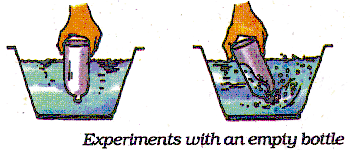
Is air present everywhere around us?
- Books Name
- Class 6 Science Book
- Publication
- PathSet Publications
- Course
- CBSE Class 6
- Subject
- Science
Is Air Present Everywhere Around Us?
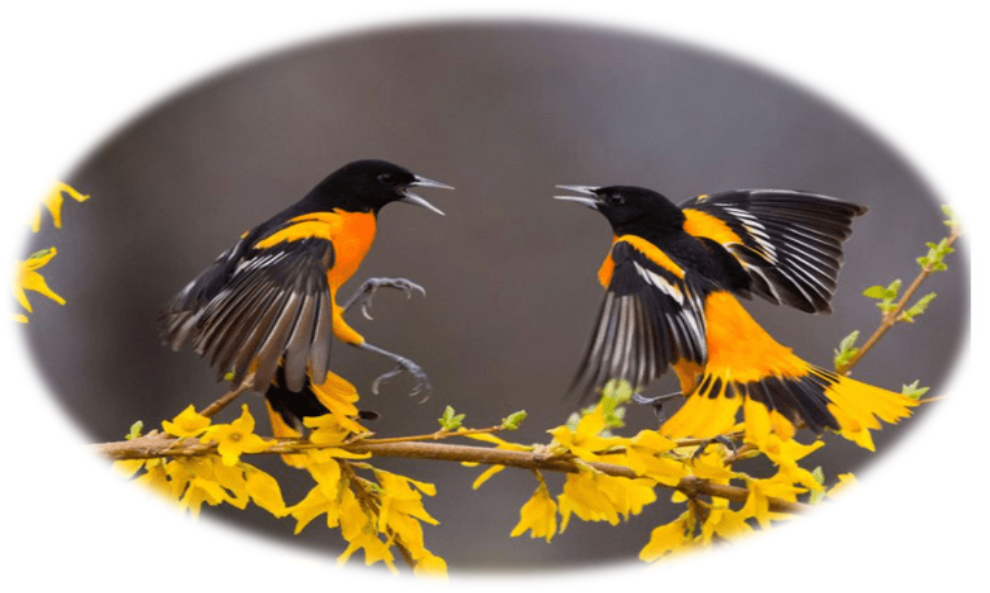
Is Air Present Everywhere Around Us?

Air is present all around us. We cannot see the air around us but we can feel its presence when the leaves rustle or branches sway.
Importance of Air
- We need air for breathing.
- All living beings need air for breathing.
- We need air to burn something.
- Life is possible on earth because of air.
The invisible gaseous medium around us, mainly constituted by oxygen and nitrogen is known as air. It is through this air that we are able to carry out the process of respiration. Air is transparent and colourless. It occupies space and is present all around us.
Atmosphere: The thin blanket of air surrounding the surface of the Earth is called the atmosphere.
The atmosphere is divided into five distinct layers on the basis of variations in temperature that changes due to increasing altitude. Air gets scant as we move up in the atmosphere. These are as follows:
- Troposphere: This is the first layer to the atmosphere which is nearest to the surface and is responsible for weather conditions. The troposphere itself is said to contain about more than 75% of the atmosphere!
- Stratosphere: This is the layer just above the troposphere which contains the ozone layer and where the aeroplanes fly and is also home to most of the clouds!
- Mesosphere: This is the third and the coldest layer of our atmosphere and extends to a good 80 km above the surface of the Earth.
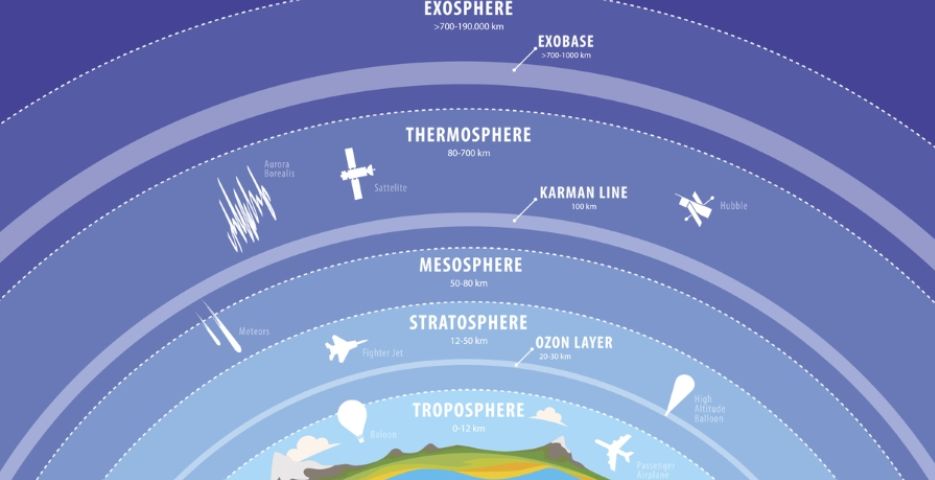
- Thermosphere: This is the fourth and one of the hottest layers of Earth where temperatures go to a 1500o This is where the space shuttles go to study Earth from space! The air in this layer is very thin and about 99.9% of the atmosphere is said to lie below this particular layer.
- Exosphere: This is the outermost layer of the atmosphere where molecules and atoms escape into space. Beginning at 480 km above the Earth, this layer then extends into the space.
Is air present everywhere around us?
- Books Name
- SonikaAnandAcademy Science Book
- Publication
- SonikaAnandAcademy
- Course
- CBSE Class 6
- Subject
- Science
Air is present around us everywhere
Eg in tyres in balloons
What is air made up of?
- Books Name
- CBSE Class 6 Science Book
- Publication
- Param Publication
- Course
- CBSE Class 6
- Subject
- Science
Composition of air
Air is a mixture of several gases, water vapour and fine dust particles. A human being respires about 22,000 times everyday and takes in about 16 kg of air. Air contains mainly nitrogen, oxygen and smaller amounts of argon, carbon dioxide, water vapours and traces of helium, neon, krypton and xenon
 .
.
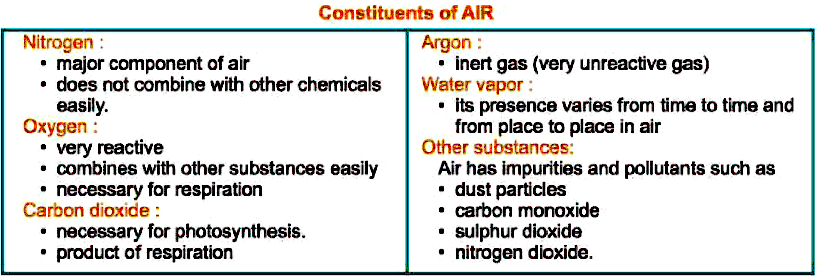
What is air made up of?
- Books Name
- Class 6 Science Book
- Publication
- PathSet Publications
- Course
- CBSE Class 6
- Subject
- Science
What Is Air Made Up of?
Air is a mixture of different gases and particles; oxygen, water vapour, nitrogen, carbon dioxide, dust and smoke.
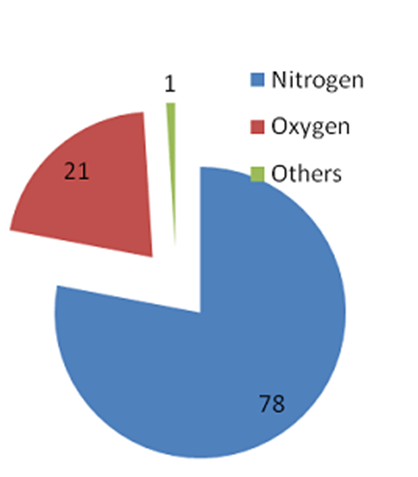
- Air is not one substance but is a mixture.
- Air is a mixture of some gases, water vapour and dust particles.
- The gases in the air are mainly nitrogen, oxygen, a small amount of carbon dioxide and some other gases.
Water vapours

Air contains water vapours.
- When air comes in contact with a cool surface, it gets cooled and fog appears.
- The presence of water vapour in the air is important for the water cycle in nature.
Dust particles

Air contains dust particles.
- The presence of dust particles in air varies from place to place and time to time.
Oxygen
- The component of air that supports burning is called oxygen.
- Oxygen is necessary for the survival of all living beings. It is required in respiration.
- Percentage of oxygen in the air is around 20.95%.
Nitrogen
- The major part of the air is nitrogen. It takes up four-fifth of the space (be around 78.11%) that air fills.
- Nitrogen does not support burning.
Carbon dioxide
- Carbon dioxide makes up a small component (0.03%) of air around us.
- It causes a feeling of suffocation.
- All materials, when they burn, consume oxygen and produce carbon dioxide.
- It is also produced along with water vapour during respiration.
- Plants need carbon dioxide for photosynthesis and to live.
Atmosphere
- Our earth is surrounded by air in the form of a thin layer. This thin layer is called the atmosphere.
- The atmosphere extends up to several kilometres.
- The air becomes thinner and thinner as we go high up from the surface of the earth.
- The atmosphere is quite active due to the movement of air, concerning the earth.
- The processes like cloud formation, thundering, rain etc., occur in the atmosphere.
Constituents of Air
Air is a mixture of a number of gases and some other particles such as:
- Water Vapour: Air contains water vapour which helps maintain the water cycle. When air comes in contact with cold surfaces, it is these vapours that turn into or condense into droplets of water. The amount of water vapor in the air from place to place and time to time. At a normal 30°C for instance can contain say up to 4% of water vapour.
- Oxygen: It is the oxygen in the air that helps humans and animals carry out the respiration process. Oxygen is also required for fire to keep burning. If we were to keep an inverted tumbler covering a burning candle, the candle will go off in a few seconds because of the lack of oxygen-containing air due to the tumbler. Dry air is said contain about 21% of oxygen.
- Nitrogen: Dry air is said to contain about 78% of nitrogen. This component of air helps plants in their growth process.
- Carbon dioxide: Carbon dioxide is a very small (only 0.04%) component of air and is a byproduct of respiration by humans and animals. Fire also uses up oxygen to burn and then produces carbon dioxide and a few other gases upon burning. This is why we feel suffocated if there is something burning inside a room. This happens due to an excess of carbon dioxide as the fire continues to burn in the room, choking out oxygen in the air.
- Dust and Smoke: Smoke is another component given out when fire burns. It is very harmful and adds fine dust particles and a few other gases to the air. This is why industries use long chimneys in order to release this smoke in the air. But as we know this act is what contributes to air pollution in the environment.
Air also contains very fine dust particles which can be seen when a beam of light enters a dark room. The tiny particles flying around in the beam are actually these dust particles. It is hence advised by our elders to breathe only through our nose and not our mouths so that the fine hair and mucus in the nose is able to filter out these dust particles so that we don’t inhale them and harm ourselves.
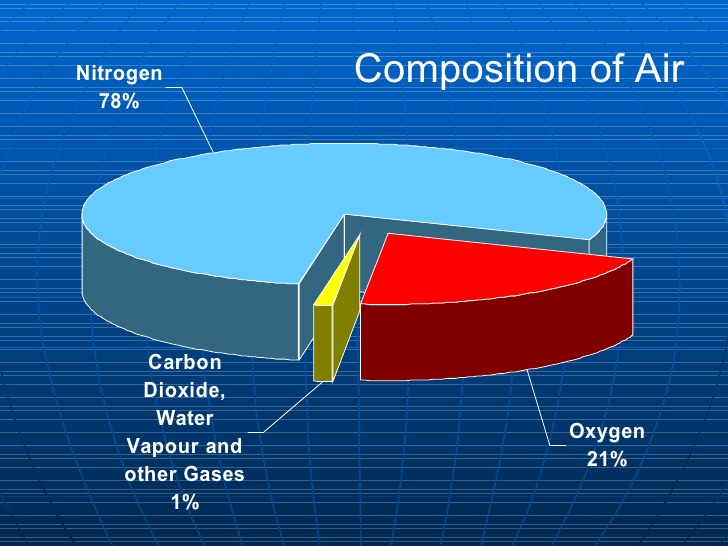
The composition of the components of air
As we can see from the Figure above, Oxygen and nitrogen together make up 99% of air while the other components come up to a mere 1% of all air in our environment.
Availability of Oxygen in Water and Soil
It is often asked how animals under the soil and in water are able to breathe. The answer is that both soil and water have air dissolved in them.
- When we heat or boil water, we often notice that bubbles start to form. These bubbles are in fact, an indication that air molecules are present in the water. When water is heated, the air dissolved in it escapes first followed by water itself getting converted into vapour. This is how animals living underwater are able to respire.
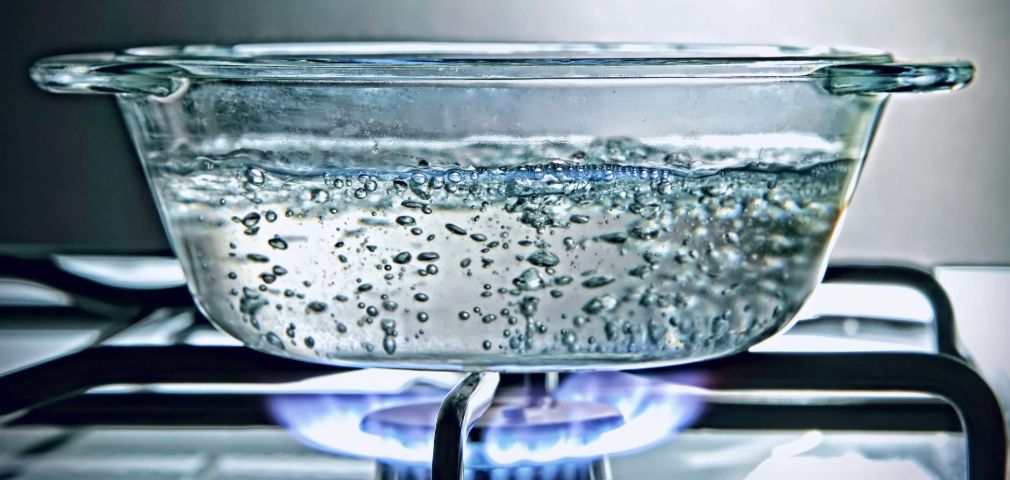
Figure 3 Air bubbles can be seen when water is heated
- To see the presence of water in the soil, we take a small lump of it in a beaker and add water to it. We see bubbles coming out of it which as we discussed, is proof of the existence of air molecules in the soil. As water is added, it displaces the water molecules in the soil which we see in the form of bubbles. Animals make use of this air to breathe under the soil. Some animals make holes and burrows in the soil to help make pathways for air to enter the soil. When it rains heavily, earthworms and other animals come out of the soil because these pathways get blocked by the water and they need to come outside to find the air to breathe.
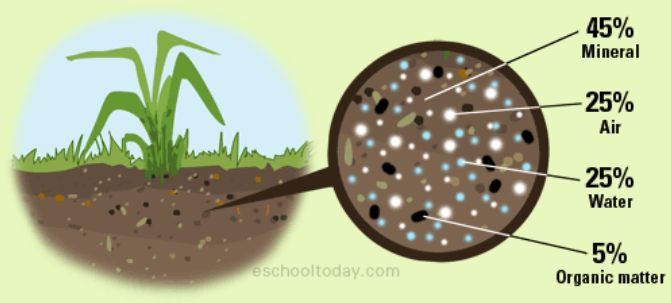
Figure 4 Air particles present in soil
How does oxygen become available to animals and plants living in water and soil?
- Books Name
- CBSE Class 6 Science Book
- Publication
- Param Publication
- Course
- CBSE Class 6
- Subject
- Science
Importance of oxygen in air
Oxygen is required for various process :
(i) Combustion : The process of burning of fuel in air with release of energy in the form of heat and light.
(ii) Respiration : a form of combustion in which oxygen reacts with food to release energy.
(iii) Rusting : the corrosion of iron when exposed to air (oxygen) and moisture (water).
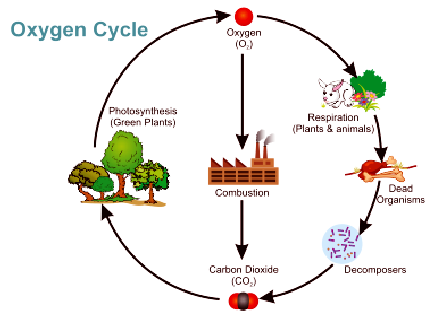
Importance of Carbon dioxide in Air
Carbon dioxide plays a vital role in living beings through Photosynthesis.
Photosynthesis : The process by which plants make their own food (glucose) using carbon dioxide and water in the presence of sunlight and chlorophyll, and release oxygen.

Note : Aquatic plants use carbon dioxide dissolved in water for photosynthesis.
Importance of water vapour in air
The amount of water vapor present in air is called humidity. In absence of water vapor
• plant leaves become dry and crumble
• animals can get dehydrated
Excess water vapor can cause discomfort, heat becomes severe even though the temperatures are not very high.
How does oxygen become available to animals and plants living in water and soil?
- Books Name
- Class 6 Science Book
- Publication
- PathSet Publications
- Course
- CBSE Class 6
- Subject
- Science
How Does Oxygen Become Available to Animals and Plants Living in Water and Soil?
In Plants:
Plants have tiny pores called stomata, found on the underside of a leaf.
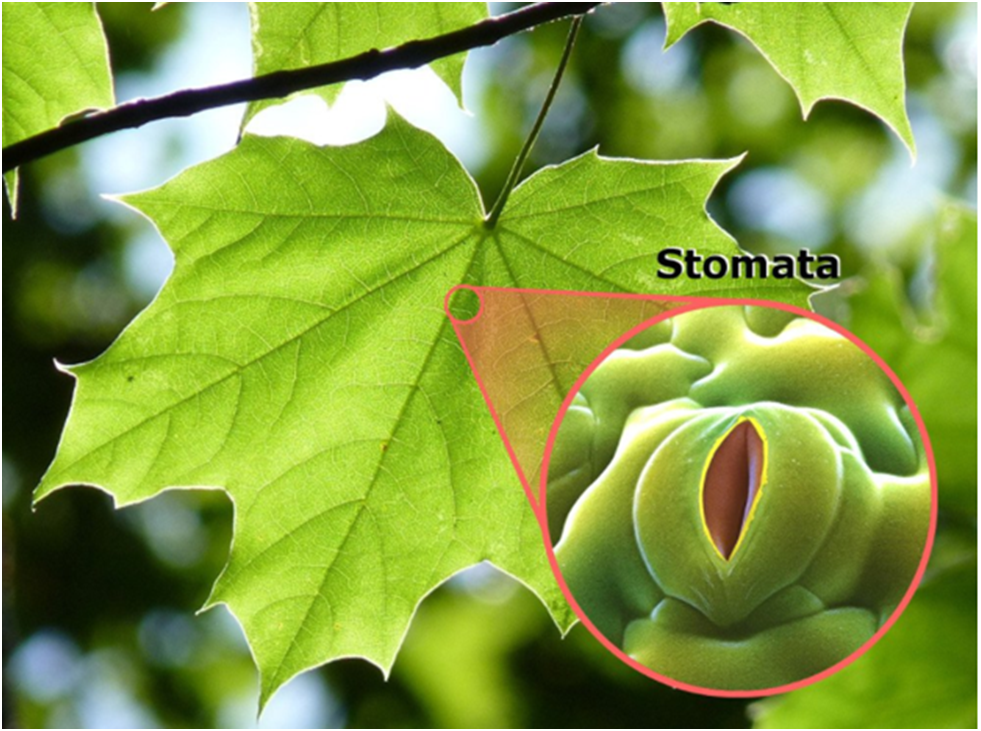
Air containing carbon dioxide and oxygen enters the plant through these openings where it gets used in photosynthesis and respiration.
In Animals:
All animals need to respire, be it a cockroach, a fish, or an elephant. It is just that they use different organs and mechanisms for respiration.
In Aquatic Animals and Plants:
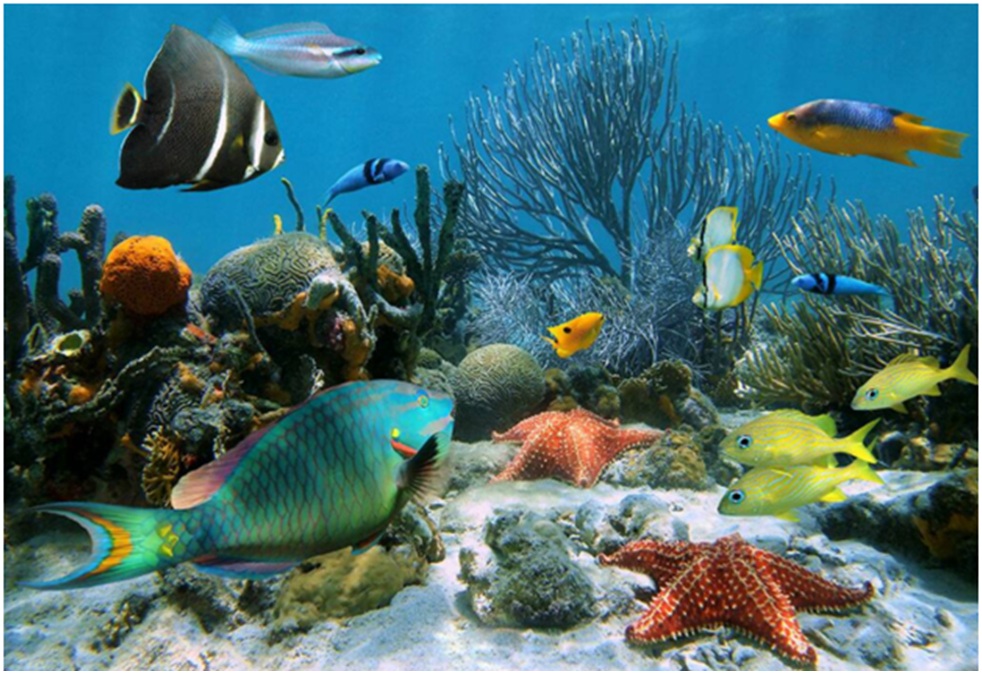
Most aquatic animals like fish, tadpoles, crabs, and shrimp have special organs for respiration called gills. Gills help to take in oxygen and give out carbon dioxide. Some aquatic animals like dolphins and whales come to the surface of the water regularly to take in air, since they breathe with the help of the lungs. Aquatic plants like Hydrilla also breathe in oxygen dissolved in water through their stomata.
In Amphibians:
Amphibians like frogs, newts, and salamanders need breathing systems for both air and water. Crocodiles and alligators swim through the water with part of their snout above the water surface to breathe easily through nostrils.
In Birds:
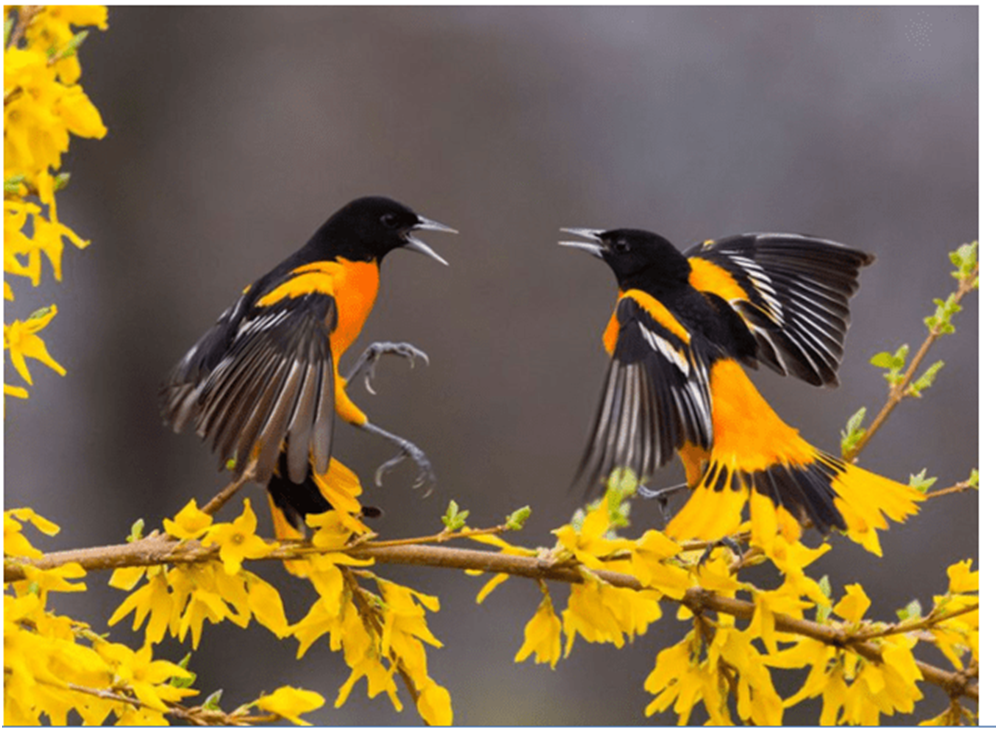
Birds have an efficient respiratory system as they need high levels of oxygen during flight. Birds have a pair of lungs with air sacs that remain open all the time so that air can easily pass through them.
In Mammals:
Most mammals breathe with the help of lungs. They take in oxygen and give out carbon dioxide.
Balance of Oxygen in the Atmosphere
It is common knowledge that humans and animals can’t survive without plants because they produce oxygen via photosynthesis. The balance of oxygen in the environment is thus maintained through the respiratory processes of plants and animals.
The importance of Air
Air has a number of uses:
- The air which is in motion is known as wind. The wind is important for the rotation of windmills which help in drawing water from tube wells.
- They also help in running flour mills.
- Windmills are also used to produce electricity.
- Insects and birds are only able to fly because of the presence of air
- Boats, yachts, aeroplanes and parachutes also need air to sail and glide
- Air has a very important role to play in the water cycle as well.
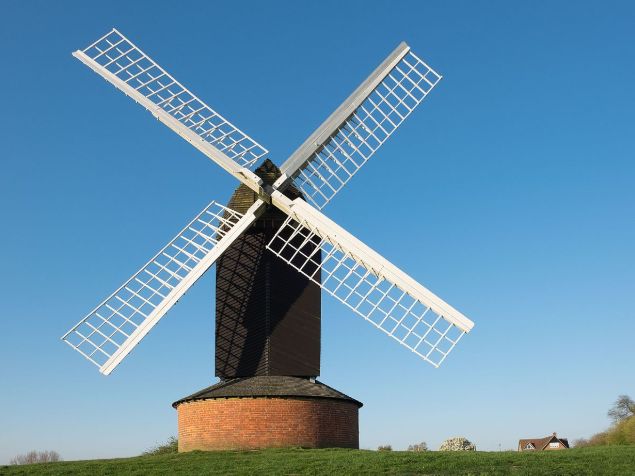
Figure 5 A windmill in action
- It also helps in distributing the pollen and seeds from flowers of various plants.
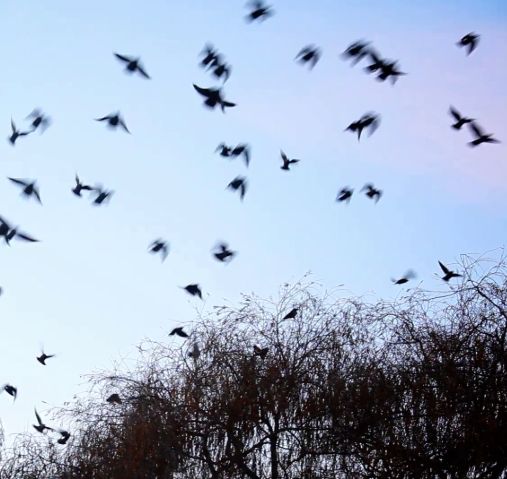
Figure 6 Air helps birds and insects fly
How is the oxygen in the atmosphere replaced?
- Books Name
- CBSE Class 6 Science Book
- Publication
- Param Publication
- Course
- CBSE Class 6
- Subject
- Science
ATMOSPHERE
The transparent , thick and invisible envelope of air surrounding us is called atmosphere.
It consist of a uniform mixture of permanent gases called dry air and varying amounts of other materials including organic and inorganic impurities such as smoke, pollen grains and dust particles.
The atmosphere is divided in various layers to facilitate the study of it.
The different layers of atmosphere (starting from the surface of earth) are troposphere, stratosphere, mesosphere, thermosphere and exosphere.
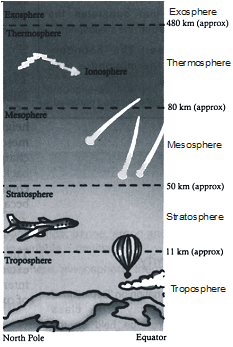
Figure : The structure of atmosphere
Troposphere : This is the lowest layer of the atmosphere. It extends to a height of about 11 km above the earth’s surface. All weather phenomena, such as clouds, fog, rainfall, snowfall, storms and lightning occur here. In this layer the temperature of air decreases with increase in height at the rate of 1° C for every 165m. As the troposphere is the lowest and the densest layer of the atmosphere, it absorbs maximum heat radiated by the earth's surface and keeps the earth warm.
Stratosphere : This layer lies above the troposphere and it extends to a height of about 50km above the earth's surface. There are virtually no clouds and very little dust and water vapour convection. The stratosphere contains Ozone which absorbs the harmful ultraviolet radiation of the sun.
Mesosphere : The layer lies above the stratosphere and it extends to a height of about 80km above the earth's surface.
Thermosphere : This layer lies above the mesosphere and it extends up to a height of 480 km. This layer contains electrically charged particles called 'Ions' so it is also called Ionosphere. These particles reflect radio waves back to the earth's surface and unable us to have wireless communication.
Exosphere : The uppermost layer of the atmosphere is called exosphere. It extends to a height of about 1600km and gradually merges with the interplanetary space.
How is the oxygen in the atmosphere replaced?
- Books Name
- Class 6 Science Book
- Publication
- PathSet Publications
- Course
- CBSE Class 6
- Subject
- Science
How Is the Oxygen in the Atmosphere Replaced?
- Organisms usually come together where each benefits from the other.
- We get oxygen and other products from plants and they get not only carbon dioxide but other advantages from us.
- This is in the form of a cycle. Respiration and photosynthesis lead to the recycling of oxygen and carbon dioxide in the environment.
Summary
- Books Name
- CBSE Class 6 Science Book
- Publication
- Param Publication
- Course
- CBSE Class 6
- Subject
- Science
Components of atmosphere :
Water Vapour :
Moisture is present as water vapour in the atmosphere. Water vapour rise high up into the atmosphere and get cooled to form clouds. These bring rain both on land and oceans. Snow is produced in cooler regions. The water vapour control the climatic conditions.
The presence of moisture can be felt in our daily life.
When air comes in contact with a cool surface, it condenses and drops of water appear on the cooled surface. This shows that water is present in air.
Oxygen : Oxygen is extremely important for the survival of organisms as organisms respire in it. Requirement of oxygen is an essential condition for burning of a substance hence it plays an important role in combustion.
The presence of oxygen in air can be felt by a simple experiment.
Activity –2
AIM : To show the presence of oxygen.
Material required : (i) two candles (ii) two shallow containers (iii) two glasses of different size
(iv) water
Mathod : Fix two small candles of the same size in the middle of two shallow containers. Now, fill the containers with some water. Light the candles and then cover each one of them with an inverted glass (one much taller than the other) as shown in the figure.
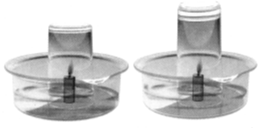
Burning can occur only in the presence of oxygen. We see that, one component of air is oxygen. Now, the amount inside each glass in our experiment, is limited. When most of this oxygen is used up by the burning candle, it can no longer burn and blows out. Also, water rises up in the glass once the candle blows out.
Nitrogen : In the above activity we observe that a major part of air is still present in the glass bottle even after the candle blew out. This indicates the presence of some component in the air, which does not support burning.
It is an important constituent of living organisms. It cannot be utilized by living organisms in elemental form. The elemental nitrogen is converted into its usable compounds like nitrate by nitrogen fixation processes.
Carbon dioxide : In a closed room, if there is some material that is burning, we feel suffocation. This is due to excess of carbon dioxide that may be accumulating in the room, as the burning continues. Carbon dioxide makes up a small component of the air around us. Plant and animals consume oxygen for respiration and produce carbon dioxide. Plant and animal matter on burning, also consume oxygen and produce mainly carbon dioxide and a few other gases.
It occurs in carbohydrates, fats, proteins, nucleic acids, enzymes and hormones. Carbon dioxide molecules reflect back the heat radiations and help the earth not to radiate heat very rapidly at night. Carbon dioxide partially dissolves in water and helps in the formation of carbonate salts. These give taste to natural water. Carbon dioxide is essential for photosynthesis.
Dust and smoke : The burning of fuel also produces smoke. Smoke contains a few gases and fine dust particles and is often harmful.
Dust particles are always present in air.
Summary
- Books Name
- Class 6 Science Book
- Publication
- PathSet Publications
- Course
- CBSE Class 6
- Subject
- Science
Summary
Conclusion:
- All living organisms need air to survive. Air cannot be seen but can be felt when it moves.
- Air is a mixture of several gases.
- Oxygen is needed for respiration. Carbon dioxide is given out as a by-product after respiration.
- Insects take in air with the help of tiny holes in their bodies called spiracles; earthworms breathe through their skin, which is kept moist with the help of a substance called mucus.
- Some aquatic animals like whales and dolphins as well as mammals breathe with the help of lungs.
- Amphibians like frogs breathe with the help of lungs, when on land. In water, these animals breathe with the help of their moist skin.
- Birds breathe through lungs and air sacs that are open all the time.
- There are several causes of air pollution: excessive burning of fuels like wood, coal, and petroleum, machines releasing gases, vehicles releasing smoke, and several types of harmful gases released by industries.
7
- Books Name
- CBSE Class 6 Science Book
- Publication
- Param Publication
- Course
- CBSE Class 6
- Subject
- Science
Activity–3
AIM : To show the presence of dust particles in air.
Method : Close all the doors and windows with curtains pulled down in a sunny room to make the room dark. Now, open the door or a window facing the sun, just a little, in such a way that it allows sunlight to enter the room only through a slit.
We see some tiny shining particles moving in the beam of sunlight.
This shows that air contains dust particles. The presence of dust particles in air varies from time to time, and from place to place.
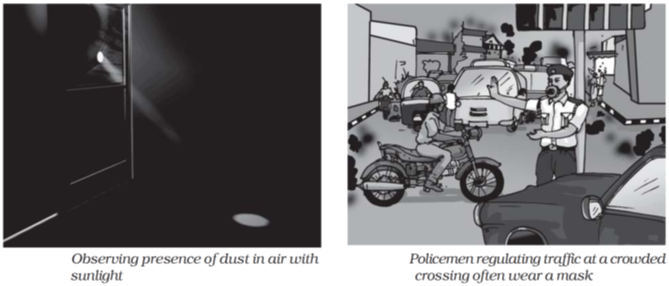
Note : We inhale air when we breathe through our nostrils. Fine hair and mucus are present inside the nose to prevent dust particles from getting into the respiratory system.
(v) Inert gases : Inert or noble gases are present in air in very small amount. These do not react with any substance but can be used in many ways.
We may conclude, then, that air contains some gases, water vapour and dust particles. The gases in air are mainly nitrogen, oxygen small amount of carbon dioxide, and many other gases. However, there may be some variations in the composition of air from place to place. We see that air contains mostly nitrogen and oxygen. In fact, these two gases together make up 99% of the air. The remaining 1% is constituted by carbon dioxide and a few other gases, water vapour and dust particles.
AVAILABILITY OF OXYGEN TO ANIMALS AND PLANTS LIVING IN WATER AND SOIL
The animals and plants living in water take in the oxygen dissolved in water.
The presence of dissolved oxygen in water can be felt by a simple experiment.
Activity–4
AIM : To show respiration of animals and plants in water and soil.
Material required : (i) water (ii) burner (iii) tripod stand (iv) lump of dry soil
Mathod : Take some water in a beaker and heat it slowly on a tripod stand. Heat it before it begins to boil. Now carefully look at the inner surface of the beaker. We see tiny bubbles on the inside.
These bubbles come from air dissolved in water when we heat it, the air dissolved in it begins to escape and we see bubbles in water.
The organisms that live in soil also need oxygen to respire. If we take a lump of dry soil in a beaker and add water in it, we can observe bubbles coming out of soil. This shows the presence of air in soil.
The plants and animals that live inside the soil respire in this air. A lot of burrows and holes are formed in deep soil by the animals living in the soil. These burrows also make spaces available for air to move in and out of soil.
However, when it rains heavily water fills up all the spaces occupied by the air in soil. In this situation animals living in the soil have to come out for respiration.
This is why earthworms come out of soil during rainy season.
HOW IS THE OXYGEN IN THE ATMOSPHERE REPLACED
- Books Name
- CBSE Class 6 Science Book
- Publication
- Param Publication
- Course
- CBSE Class 6
- Subject
- Science
HOW IS THE OXYGEN IN THE ATMOSPHERE REPLACED
Oxygen is product during the process of photosynthesis. In this process plants make their own food and produce oxygen along with it. Plants also consume oxygen for respiration, but they produce more of it than they consume. That is why we say plants produce oxygen.
Animals cannot prepare their own food, so they depend on plants for food. Thus, animals cannot live without plants.
The balance of oxygen and carbon dioxide in the atmosphere is maintained through respiration in plants and animals and by photosynthesis in plants.
The CO2 produced during respiration of plants and animals is consumed during photosynthesis by plants.
While the oxygen produced during photosynthesis by plants is consumed in respiration by plants and animals.
This shows the interdependence of plants & animals.
OTHER IMPORTANT USES OF AIR
1. Wind mill : Moving air is called wind. Wind makes the windmill rotate.
The wind mill is used to draw water from tubewells and to run flour mills. They are also used to generate electricity.
2. Air helps in sailing yachts, gliders, parachutes and aeroplanes.
3. Birds, bats and insects can fly due to the presence of air.
4. Air also helps in dispersal of seeds and pollens of flowers and several plants.
5. Air plays an important role in water cycle.
KEY WORDS
1. Atmosphere : The envelope of air that surrounds the earth is known as atmosphere.
2. Carbon Dioxide : Carbon dioxide is a gas produced during respiration. It is also produced on burning of organic substances. It is used by plants for photosynthesis.
3. Composition of Air : Air is a mixture of nitrogen, oxygen, carbon dioxide, water vapour and a few other gases.
4. Oxygen : Oxygen supports burning and is necessary for living organisms.
5. Nitrogen : It is the major portion of our atmosphere
6. Smoke : These are the dark-coloured mixture of gases produced due to the burning of anything
7. Windwill : windmill is a huge apparatus which is rotated by wind. It is used to draw water from tube wells and to run flour mills.

 Param Publication
Param Publication
 PathSet Publications
PathSet Publications
